序章
現在、 LED表示画面 have become an indispensable part of these landmark buildings. They not only light up the night of the city, but also become a display window for urban culture and commerce.
But do you know? It is not easy to create a successful LED display landmark building. There are many details and key points that require us to think carefully.
目次
Note 1: It is necessary to clarify the functional positioning of the city landmark
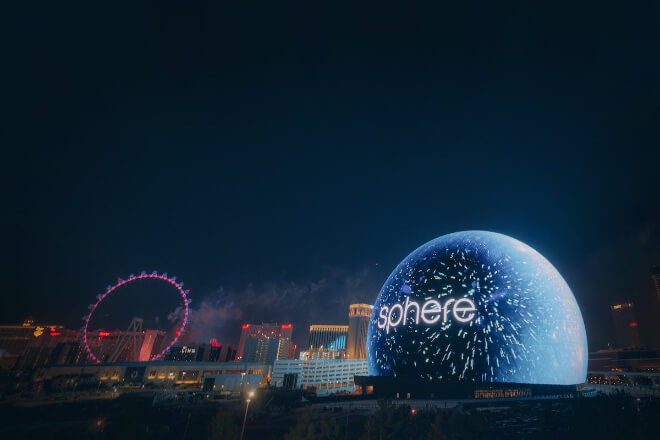
1). City image display window
This LED display screen is like a “big screen” of the city, which should show the beauty and characteristics of the city.
For example, the beautiful scenery, monuments, new buildings, and the like of the city can be filmed into videos or pictures, and played on them, so that passers-by can see the unique charm of the city at a glance.
It’s like when you go to a strange place and see the LED display screen on the landmark building showing various beautiful pictures of the local area, you will have a good impression of this place and think it is very distinctive.
For example, the Bund in Shanghai, where the LED display screen often plays some videos showing the history and modern style of Shanghai, allows people to feel the charm of the city at a glance.
2). Combination of public art and commerce
LED display screens should show art and take into account business. In terms of art, you can put some creative patterns and light and shadow effects, just like placing a large piece of art in the city, which makes people feel pleasing to the eye.
In terms of business, it cannot be ignored. After all, commercial advertisements can also bring vitality to the city.
However, advertisements should be placed cleverly and should not destroy the overall artistic sense.
For example, you can display some works of art during the day and play some commercial advertisements at night.
Or design the advertisements more creatively and integrate them with the artistic content. In this way, the LED display screen can not only display art but also bring commercial value.
3). Citizen activities and interactive platform
This LED display screen must also be a “big ステージ” for citizens. It can display various activities of citizens.
Such as community art performances, festival celebrations, etc., so that citizens can see their lives being displayed and feel more belonging.
Moreover, some interactive links can be set up, such as allowing everyone to participate through mobile phone voting, sending blessings, etc.
For example, during the New Year, citizens can send blessings through their mobile phones.
And these blessings will appear on the LED display screen of the landmark building, allowing everyone to feel the strong festive atmosphere.
4). The unity of “beauty” and “use”
The appearance of the LED display screen should be properly matched with the building itself and the surrounding environment, and should not appear out of place.
At the same time, its content should also be practical, and should be able to meet various needs such as displaying the city’s image, spreading art, doing commercial publicity, and promoting citizen interaction.
For example, if the landmark building is modern, the LED display screen can be designed to be simple and technological.
If it is a historical and cultural building, the display screen can be designed to be more classical.
Only if it is both beautiful and practical can this LED display screen really play its role and become a bright part of the city’s landmark building, adding value to the city and making citizens and tourists feel that it is valuable.
Note 2: Choose high-specification LED display technology
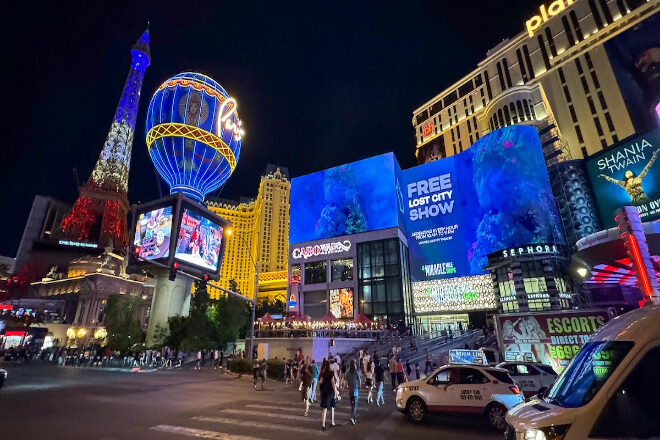
1). 高い 輝度 and high contrast ensure day and night visibility
In short, the LED display screen must be bright enough and have a high contrast so that people can see it clearly during the day and at night.
Just like those big screens in Las Vegas, no matter how big the sun is during the day or how bright the lights are at night, the content on it can be clearly displayed, attracting everyone’s attention.
2) Ultra-high definition (4K/8K) brings a shocking visual experience
Ultra-high-definition LED display screens are like watching a football game on a high-definition TV.
The picture is very delicate, and even the sweat on the players’ faces can be seen clearly. This ultra-high-definition screen can make the audience feel an immersive visual shock.
For example, the LED screen of the Qatar World Cup, the audience can see every action even from a distance, and this visual effect is really great.
3). Optional curved/special-shaped/transparent screens to improve the integration of buildings
Sometimes, the shape of the building is very special, and at this time, some special LED screens are needed to match it.
For example, the curved screen can fit the curvature of the building, so that the display screen and the building are perfectly integrated.
The special-shaped screen can be customized according to the shape of the building, and the transparent screen can show the internal structure of the building through the screen.
For example, the “big water tank” LED screen on the streets of Seoul, South Korea, uses curved technology to simulate the effect of waves.
It is not only beautiful, but it can also automatically adjust the brightness according to the position of the sun, making the whole building look more harmonious.
4). Support remote content control and intelligent dimming
Nowadays, LED displays are getting smarter and smarter. Remote content control means you can update the content of the screen through the network anytime and anywhere, without having to go to the site every time to operate.
Intelligent dimming can automatically adjust the screen brightness according to the ambient light, which is both energy-saving and environmentally friendly.
For example, the MSG Sphere in Las Vegas is an LED screen system that supports remote control and intelligent dimming, making the management and maintenance of the entire screen super easy, and also saving a lot of electricity.
Note 3: The design of the LED display screen should integrate the architectural style
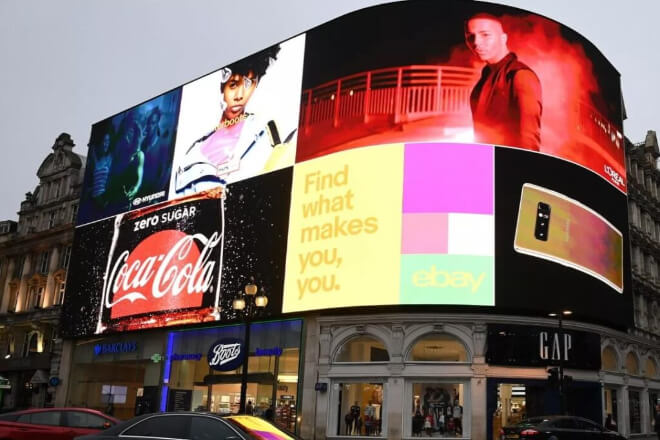
1). Integrated design of the facade structure and the LED screen
Imagine that you see a building whose facade and LED screen are perfectly combined, as if they were born as one.
This integrated design makes the LED screen look like it is not simply “pasted on” but truly “integrated” into the building.
For example, some buildings in Times Square in New York have their facades and LED screens integrated designs, which look very natural and harmonious, without any sense of disobedience.
2). Avoid the feeling of “pasting on” and achieve “integration”
Sometimes, if the LED screen is simply installed on the surface of the building, it will give people a very abrupt feeling, just like “pasting a piece of paper” on the building.
In order to avoid this feeling, the design should make the LED screen and the style, material, color, etc. of the building consistent.
For example, some modern buildings in Dubai have LED screens that perfectly blend with the lines and shapes of the building, and look like part of the building rather than an additional decoration.
3). Customized installation in combination with curtain walls, glass, columns, and other structures
The installation of LED screens cannot be “one size fits all”, but should be customized according to the specific structure of the building.
For example, if the building has a large area of curtain walls, the LED screen can be designed to be transparent, so that it can display the content without blocking the light inside the building.
If the building has columns, the LED screen can be designed around the columns to increase the visual three-dimensional sense.
Some buildings, like Paris, have LED screens that combine the structure of curtain walls and columns, which are both beautiful and practical.
4). Coordination of LED color temperature with urban building materials
The color temperature of the LED screen is also very important. It should be coordinated with the material of the building and the style of the entire city.
If the building is warm-toned, the color temperature of the LED screen should also be warm, so that it will look harmonious.
For example, in some ancient European cities, most of the buildings are made of warm stone tones, so the color temperature of the LED screens there will be warmer, blending in with the style of the entire city.
Note 4: Safety and maintenance difficulty must be strictly considered
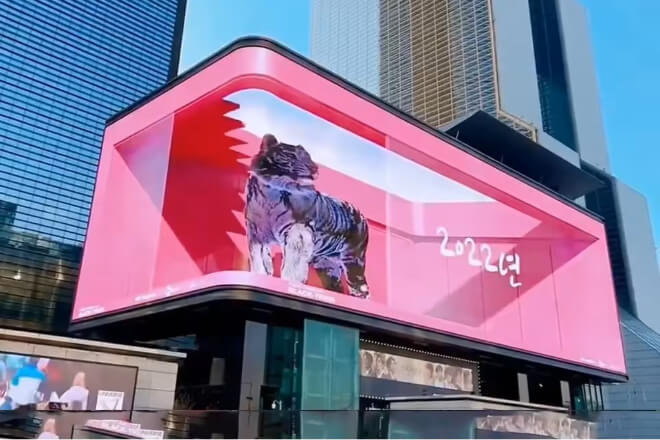
1). Windproof, lightning-proof, waterproof, shockproof, and fireproof design
Imagine that your LED display must be able to withstand all kinds of bad weather. For example, at the seaside, strong winds and waves are common, so windproof and waterproof clothing is particularly important.
The buildings on the Dutch seaside have LED displays designed to be particularly strong and can withstand the impact of strong winds and waves.
Lightning protection is also critical, especially in places with frequent thunderstorms, where lightning protection devices must be available.
Earthquake and fire prevention should not be ignored. There are many earthquakes in Japan, and the display screens there are well designed to prevent earthquakes, ensuring that they will not be damaged.
These protective measures can not only extend the service life of the display but also reduce damage caused by natural factors.
For example, some high-rise buildings in Dubai have LED displays that are not only windproof and waterproof but also pay special attention to fire prevention to ensure safe operation in high temperatures and dry climates.
2). Module stability and redundant backup
The LED display screen is composed of modules, which must be stable and reliable. Just like the large screen in the stadium.
Once a module breaks down, the backup can immediately take over, and the audience will not see a black screen, ensuring the experience.
This design can not only improve the reliability of the display screen, but also reduce maintenance costs and time.
For example, some large スタジアム in the United States use advanced module stability and redundant backup mechanisms for their LED display screens.
Which can maintain stable operation even under high-intensity use, ensuring that the audience will not miss any exciting moments.
3). Support and heat dissipation of high-altitude and ultra-large screens
High-altitude and ultra-large screens need to pay special attention to support and heat dissipation.
The high-rise large screen in the UAE has a very stable structure and advanced heat dissipation technology, so that the screen can work normally under high temperatures and strong winds.
A good heat dissipation design can not only prevent the display screen from overheating but also improve its stability in extreme weather.
For example, some large entertainment venues in Las Vegas their ultra-large LED display screens that are not only supported by a solid structure.
But also equipped with an efficient heat dissipation system to ensure stable operation in high temperature environments throughout the year.
4). Easy to replace modules and maintenance channels
The design should be convenient for module replacement and maintenance. For example, the large screen on the exterior wall of the shopping mall has a special maintenance channel.
Which maintenance personnel can easily reach and quickly solve problems, reducing the impact on the use of the screen.
Reserving sufficient maintenance channels can not only facilitate daily maintenance, but also quickly repair when a fault occurs, reducing downtime.
For example, some commercial buildings in Paris their LED display screens that have easy-to-replace module designs.
Sufficient maintenance channels are also reserved to ensure that maintenance personnel can quickly reach any part that needs repair, improving maintenance efficiency.
Note 5: Long-term operation and update mechanisms need to be clearly planned
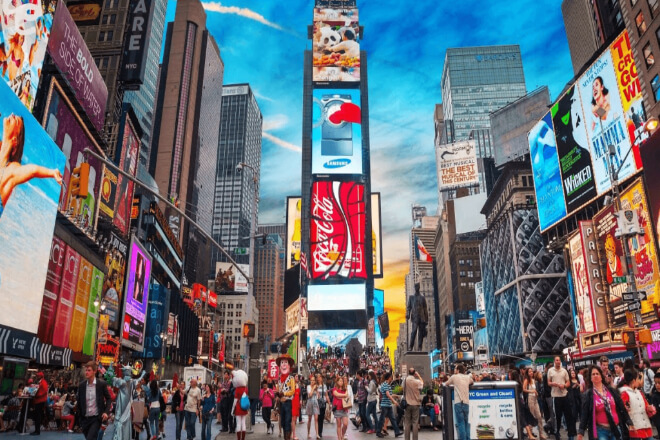
1). Division of responsibilities between content planners and operating units
It is necessary to clarify who is responsible for what content. Content planners must think about what to put on the screen, whether to promote urban culture or advertise.
The operating unit is responsible for displaying the planned content on time and in quality. If there is any problem with the screen, they must repair it as soon as possible.
This is like a team collaboration, the planner is the “brain” and the operating unit is the “hands and feet”. Only with a clear division of labor can the screen be kept in the best condition.
2). Adopting an open platform facilitates the connection of third-party content
The screen must be able to “shake hands” with external content. Adopting an open platform can facilitate access to third-party content.
This can not only enrich the content of the screen but also increase commercial value.
For example, it can connect to the works of local artists, public service advertisements, and even some temporary activities to make the content of the screen more diverse.
3). Regular inspection and maintenance, and a hardware update plan
The screen must be regularly “checked” and “replaced”. Regular inspection and maintenance can detect minor problems with the screen and prevent them from becoming major problems.
The hardware update plan can keep the screen “young” and keep up with the development of the times.
As time goes by, technology continues to advance. Timely updating of hardware can ensure that the screen can always present the best effect and avoid affecting the display quality due to the aging of the equipment.
4). Balancing the dual goals of commercial benefits and cultural display
The screen must be both “profitable” and “cultural”. A balance must be found between commercial benefits and cultural display. This can not only meet commercial needs, but also show the cultural charm of the city.
For example, the city’s history and culture can be displayed during the day to attract tourists; commercial advertisements can be played at night to increase revenue.
This balance not only allows the screen to continue to operate, but also improves the overall image of the city.
In short, the long-term operation and update mechanism must be clearly planned, so that the LED display can play its role in the city for a long time, which is both beautiful and practical.
6. 結論
Through the discussion of the above precautions, we have a clearer understanding of how to use LED display screens to create city landmark buildings.
LED display screens are not only the decoration of buildings, but also the embodiment of urban culture and commercial vitality.
I hope this content can provide some valuable references for those who are planning or already have LED display screen landmark buildings.
最後に、LEDディスプレイスクリーンについてさらに詳しく知りたい場合は、 ご連絡ください。
